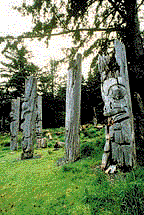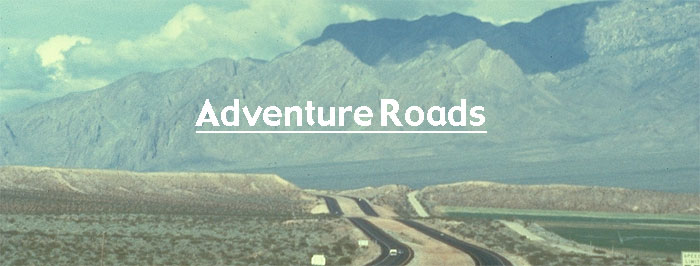|
I
am the
Yellowhead
by
Jerry W. Bird
 Heading
westward from Jasper National Park,
through the famous "Yellowhead Pass," I
enter British Columbia, Canada's most
westerly province. Near the Continental
Divide at Tete Jaune Cache, in the shadow
of Mount Robson, tallest peak in the
Canadian Rockies, I give the motorist two
pleasant options. One of my arms extends
south along the North Thompson River
beside Wells Gray Provincial Park to
Clearwater, and on to Kamloops, Merritt
and Hope. My other arm, slightly longer,
points northwest, following the Fraser
River to Prince George. From there I
continue to Prince Rupert and Masset on
the Pacific's Inside Passage to Alaska .
Continuing west beyond McBride is Bowron
Lake Provincial Park and plenty of great
riverside stops for photography, a picnic
lunch or fishing
expedition. Heading
westward from Jasper National Park,
through the famous "Yellowhead Pass," I
enter British Columbia, Canada's most
westerly province. Near the Continental
Divide at Tete Jaune Cache, in the shadow
of Mount Robson, tallest peak in the
Canadian Rockies, I give the motorist two
pleasant options. One of my arms extends
south along the North Thompson River
beside Wells Gray Provincial Park to
Clearwater, and on to Kamloops, Merritt
and Hope. My other arm, slightly longer,
points northwest, following the Fraser
River to Prince George. From there I
continue to Prince Rupert and Masset on
the Pacific's Inside Passage to Alaska .
Continuing west beyond McBride is Bowron
Lake Provincial Park and plenty of great
riverside stops for photography, a picnic
lunch or fishing
expedition.
Prince
George
Spirit of the
North. To wilderness adventurers,
canoeists, hikers and
anglers,
Prince George
is a gateway to paradise, and little
wonder. A quick glance at the road map
will tell you why. It's the Northwest's
crossroads of highways, railways, trails
and waterways, central to an immense
recreation, forestry and trading area.
Located where the Fraser and Nechako
rivers meet, this former Hudson's Bay
Company fort offers easy access to
numerous fishing lakes, linked by a superb
trail system. Explorers Alexander
Mackenzie and Simon Fraser, who traveled
these same arteries in the late 1700s, had
great visions for the area. Both would be
awestruck by the large, modern city that
has evolved, with over 120 parks, a major
university and one of BC's busiest
airports. Visitor attractions abound, from
Fort George Park, Fraser Fort George
Regional Museum Regional Museum, the
Heritage River Trail to the Prince George
Railway and Forest Industry Museum.
Adjacent to the University of Northern
British Columbia is "Forests for the
World," a 106 hectare forest project that
includes Shane Lake and a panoramic view
of the city. A relatively new Provincial
Courthouse, Civic Center and Plaza are
other symbols of civic pride. Pacific Rim
ties are strengthened by faculty and
student exchanges with universities in
Japan, Korea and New Zealand. The annual
Prince George Air Show in July and Salmon
Valley Country Music Festival are key
events. The area's economy is forest
industry-based, with 15 sawmills and 3
pulp mills. Pacific Rim ties are a key to
the area's future. Thanks to the
university, this position is strengthened
by faculty and student exchanges with
universities in Japan, Korea and New
Zealand.
Vanderhoof
Bullseye! The town of Vanderhoof is
right in the geographical center of
British Columbia. The name came from
Herbert Vanderhoof, a government agent ,
who launched a publicity campaign to
attract settlers to Western Canada in
1908.
Fort. St.
James
From Prince George, a pleasant side
trip to Fort St. James takes you through
ranch country, by rivers lined with
cottonwoods and sparkling lakes. Fort St.
James was founded by explorer Simon
Fraser, in 1806. At Fort St. James
National Historic Site, BC's oldest
continuously inhabited community salutes
its fur trading past. History lives on at
this authentic Hudson's Bay Trading Post,
with furs, trade goods, and staff in 1890s
attire. One of the west's oldest fur
warehouses, a clerk's residence and a fish
cache remain.
Burns Lake
The community of Burns Lake is central
to the "Lake District," which produces
rainbow trout up to 15 pounds, Char (Lake
Trout) up to 30 pounds, and a variety of
other finny fare. Wildlife is also
abundant. In the early 1900's the town was
a major supplier of railroad ties for the
Grand Trunk Pacific Railway. Today's
economy is based on logging, lumber
production, agriculture, ranching, and
tourism. Burns Lake is the main gateway to
Tweedsmuir Provincial Park, second largest
in British Columbia.
Houston
Smithers
Smithers, in the heart of the fertile
Bulkley Valley has taken on an Alpine
theme, and Hazelton
on the Upper Skeena is "Totem Pole Capital
of the World." At K'san Village, tribal
houses feature paintings, screens and
carved interior poles, and dancers perform
Indian rituals. Historic sites dot this
heartland of the Tsmishian, Kitsumkalum
and Gitskan, where Emily Carr made many of
her sketches.
The
Hazeltons
"Ksan Indian Village &endash; a nearby
historic reconstruction &endash; occupies
a site, at the junction of Bulkley and
Skeena rivers, where a centuries-old
Gitksan community stood in the 1870s, when
the first settlers arrived. The newcomers
renamed the Indian Village, originally
known as Git-an-maks ("the place where the
people fish by torch light"). The heavily
forested region within a 65-km radius is
sacred to the Gitksan. Among the village's
reconstruct ions are six communal long
houses, all embellished with paintings and
carved poles of traditional design. The
Frog House of the Stone Age features early
methods of making clothes and utensils
from cedar bark. The Wolf or Feast House
shows Gitksan life after white traders
introduced blankets, iron kettles and
muskets. The treasure Room and Exhibition
Centre displays costumes, handicrafts,
carvings and other objects. Guided tours
are available. Traditional dance
performances are scheduled in
summer.
Kitwanga
North to Alaska. At the village of
Kitwancool, just north of Kitwanga,
visitors can see the world's largest
standing totem pole,
"Hole-through-the-Ice," just one among
many historic totems in this region. From
Kitwancool, you can take the
Cassiar-Stewart Highway (37) which leads
north to the Upper Liard in Canada's
Yukon.
Terrace
Beyond Terrace, the Skeena, called River
of Mists by the Gitskan, widens into a
broad lake, meeting the Pacific at Port
Edwards, site of the 1889 North Pacific
Cannery
Port Edward
Fishing is Port Edward's mainstay
industry &endash; as visitors to its busy
waterfront discover. Items relating to
this industry are exhibited in the North
Pacific Cannery and Museum, which is
engaged in an ongoing restoration of one
of the oldest canneries on the British
Columbia coast. Stretching northwest from
Port Edward is Chatham Sound, a noted
recreation spot for boating enthusiasts
and fishermen.
Prince
Rupert
A Canadian travel editor described his
experience this way. "I first saw
Prince
Rupert from the
deck of The Princess Louise, a CPR
passenger ship that plied the Inside
Passage to Alaska, just 64 km upcoast. The
harbor was alive with canneries, fishing
fleets, coastal ferries, deep-sea ships,
and a huge grain elevator - it was
fascinating." Today, the city is buzzing
with news of a long awaited cruise ship
industry that will help realize the dream
of Mr. Hayes, Prince Rupert's biggest
booster. His plans went down when the
Titanic struck an iceberg. You can take
the world's second steepest gondola ride
on Mount Hayes, enjoy an archeological
boat tour, or board BC Ferries' Queen of
the North for a 15-hour cruise to Port
Hardy on Vancouver Island. The Museum of
Northern BC has totem pole carving on
site, and 10,000 year old works of art.
Outdoor activity abounds in some of the
wildest country on the
continent.
 Haida
Gwaii- Canada's
Galapagos Haida
Gwaii- Canada's
Galapagos
So you think you've conquered the
Yellowhead, right? Wrong!
There's still a short trip by sea to the
Haida Gwa'ii, our Western Mile "0."
From
Prince Rupert your voyage to the "Misty
Islands" is a salty experience. These
fog-shrouded waters of the Haida Gwa'ii or
Queen Charlotte Archipelago teem with
salmon, herring, halibut, rockfish,
mussels, crab, starfish, sea urchin and
octopi. Armadas of Gray, Humpback and
Killer Whales skip along the
surface.
Seabirds abound, and near
Cape
St. James, sea
lions romp and play. Isolation from the
mainland has given rise to a unique
subspecies of wildlife. Gwa'ii Haanas
National Park Preserve is also called
South Moresby. Since the park has no roads
or facilities, visitors must be self
sufficient. Anthony Island's abandoned
village, Ninstints, is a UN World Heritage
site. There are over 500 archeological and
historical Haida sites.
Now
you've earned bragging
rights:
We hope your pictures turn out great,
especially the wildlife scenes (nudge,
nudge). As the sun sets on the Haida
Gwa'ii, and your kayak rocks gently on the
tide, we'll turn off today's movie and bid
good-bye. If you take the trip, send us a
postcard. We're sure you'll savor every
moment -- and are likely
to plan many happy returns!
Continued:
BC
Southern Route
Why
not consider a ferry trip to
Port
Hardy on
Vancouver Island and back to the mainland
via Victoria or
Nanaimo?
Contact
Yellowhead Highway Association.
|
